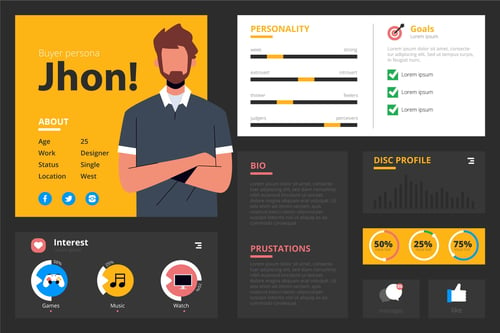Index Content
Creating your buyer persona is the basis of any digital marketing strategy that you carry out. However, many companies do not take this into account, they invest effort and money in a campaign to attract customers, without having a clear idea of the audience they need to target. This is one of the main reasons why marketing campaigns fail.
The first step is to know the people you want to reach with your brand. This is where buyer personas come in, whose creation will allow you to define your audience, understand their concerns and needs, and get to know them in depth.
If you want to know what a buyer persona is and how to create one, you've come to the perfect post. Keep reading so you don't miss anything.
what is a buyer persona?
A buyer persona is a semi-fictional representation of your ideal customer. Its creation will help you get to know your audience in detail and thus create digital marketing strategies oriented to their needs. It is used with the objective of attracting and converting customers, and it also helps you to humanise them.
The figure of the buyer persona is important because you will know the motivations, needs, goals, challenges and personal circumstances of your ideal customer. If you perform this task well, you can better optimise your efforts to offer them better solutions, which translates into conversions because they see your brand as the solution to their problems.
To create this representation of your customers, you need to research their goals, behaviour, pain points, and personal and demographic information. Everything from where they live to their purchasing power is important,
Now that you know what it is, we explain step by step how to create yours.
how to create a buyer persona template?
Now that you understand the buyer persona concept, it's time to put it into practice and create the document that reflects this profile. Here are the steps to follow, from the research phase to the moment of creating a template so that you can consult it whenever you need it.
-
collect information about your customers
The first thing you need to do is to gather as much information as possible from previous experiences, interviews and surveys you conduct with your customers, ask acquaintances about your brand, etc. Use lead intelligence tools, rely on your database, both to create a list of customers and to get to know your contacts better.
Do a good research, and that involves all the departments of your company, don't just ask the marketing department. This way you will get a broader and more detailed profile of your customers.
-
data that should be included in your buyer persona profile
- it is important that you baptise your customer with a first and last name, this should correspond to the characteristics of your consumers and languages, i.e. if you are in Spain, do not baptise them with a name in English.
- demographic characteristics: Here consider all the data that will complete the profile of your buyer, such as age, place of residence, studies, etc.
- brief description of their personality: Define their character, knowing how your customer behaves will help you to focus your strategies.
- analysis of interests and objectives: At this point you should include both personal interests and objectives, as well as purchase objectives.
- behaviour on social networks: what they post, where they post, what they react to, etc. Write down all their behaviour on digital media.
-
questions to ask yourself to create your buyer persona
The above data must appear in your template, but to describe your customer and fill in each part of their profile you must ask many questions to complete it in the best possible way. Here is a small list:
- demographics: where do you live, how old are you, how many children do you have?
- personal situation: what have you studied, what do you do for a living, what do you do for a living, what do you do for a living, what do you do for a living...?
- objectives and goals: What are your main challenges, what are your goals in your business or life?
- how you consume information: Do you read often, do you use social networks, what are your favourite websites?
- shopping behaviour: do you shop more online or in a physical shop, what is the last thing you bought, how do you prefer to communicate with the company, how do you prefer to communicate with the company?
This is just a small example of all the questions you should ask yourself to create as complete a profile as possible. The aim of the interviews is to understand what the needs, challenges, goals and behaviour of consumers are. If you are clear about this, you can focus your campaigns to meet their pain points.
-
capture all the information in a template
Creating your template is the last and easiest step. After gathering all the information and analysing it, it is time to put it into a document that you can refer to whenever you need it.
Here are Hubspot's customisable templates or their buyer persona generator to make it easy for you to create one .
We show you an example of how a template filled with the collected data would look like:

We recommend that you keep working on your buyer persona. It is important that you update the profile from time to time because the market changes, and therefore, tastes and consumer habits can change.
In short, shaping one or more buyer persona profiles (depending on your product, campaign or project you will need one or more profiles), will help your company to properly focus each marketing strategy you carry out.
we hope you enjoyed this post!





